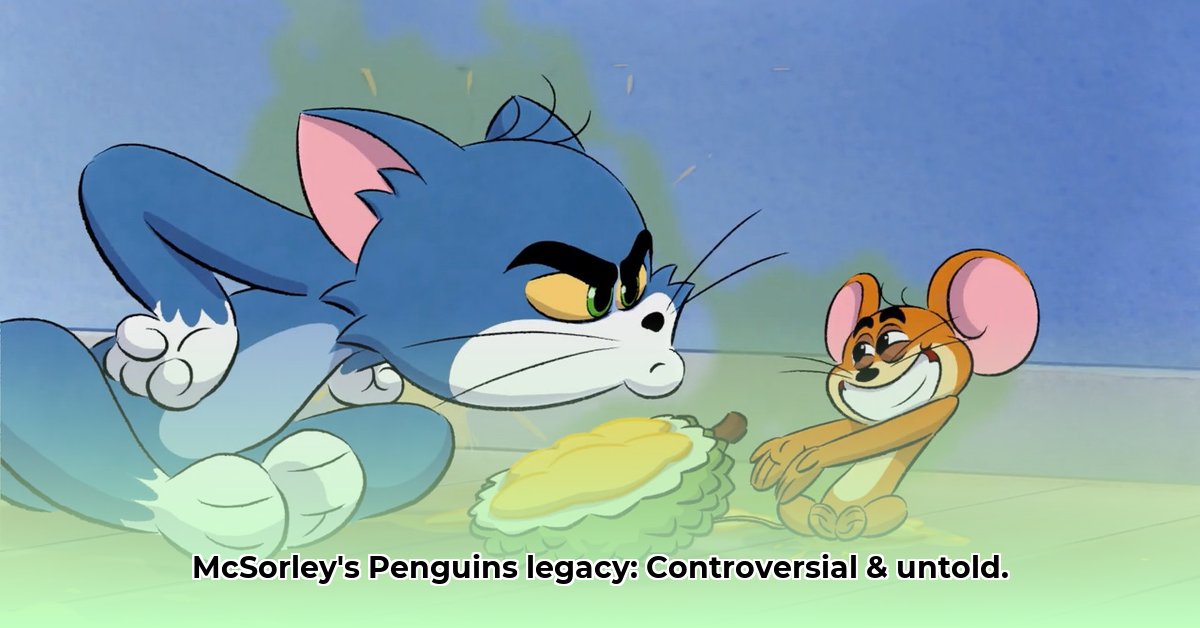Marty McSorley’s time with the Pittsburgh Penguins was a memorable one, defined by his role as a heavyweight enforcer integral to the team’s physical presence. This exploration goes beyond mere fights, examining the evolving role of enforcers in the NHL and the questions surrounding player safety and team dynamics. We delve into the complexities of his career, his contributions, and the controversies that ultimately shaped his legacy.
Jerry McSorley and the Pittsburgh Penguins: A Legacy Forged in Ice and Controversy
Marty McSorley’s tenure in Pittsburgh, while relatively brief, left a significant and frequently controversial mark. During that era, enforcers played a vital role on a team. McSorley, in contrast to some enforcers, possessed skating and passing capabilities, providing more than just physical strength.
His core function was straightforward: safeguard the team’s star players. His imposing stature and willingness to engage in physical confrontations made him a valuable asset. However, the era was characterized by intense physicality, and his role involved considerable violence, raising questions about its necessity and ethical implications. His loyalty was evident, but sometimes overshadowed by his aggressive style.
The boundaries between defending teammates and initiating brawls were often indistinct for McSorley. His reputation as a formidable fighter was legendary, but it also ignited considerable controversy. A particularly severe incident involving a high stick to an opponent late in his career significantly tarnished his image and overshadowed his contributions.
McSorley’s career mirrors the evolution of the NHL, with its increasing emphasis on player safety and decreasing tolerance for violence. His story serves as a testament to the shifting values within the sport, prompting reflection on his impact—positive or negative—and the complexities of evaluating his legacy. The lasting impact of McSorley’s career compels us to confront the realities of violence in professional hockey. Where do we draw the line regarding acceptable physicality? How do we reconcile the excitement of the game with the well-being of its participants? The debate, fueled by McSorley’s legacy, continues.
Analyzing McSorley’s Pittsburgh Penguins Tenure: A Balanced Perspective
Explore diverse perspectives on Marty McSorley’s time with the Penguins, revealing the multifaceted nature of his contributions and controversies.
| Aspect | Positive Interpretation | Negative Interpretation |
|---|---|---|
| On-Ice Physicality | Provided vital protection for skillful, sometimes vulnerable teammates. A necessary role in the hockey of that era. | Engaged in excessive violence, resulting in injuries to himself and his opponents, making the game considerably less safe. |
| Contributions to Team Success | Instilled a sense of team unity and fearlessness amongst his teammates; boosted morale through unwavering loyalty and willingness to fight for the team. | Promoted a culture that normalized and even encouraged violence, potentially harming the team’s image and long-term success. |
| Legacy | A tough, loyal defender who embodied the spirit of a bygone era of hockey; fiercely protective of his teammates and played with grit and determination. | A symbol of an outdated and dangerous style of play; his violent actions left a negative legacy that overshadowed his more positive attributes. |
The ongoing discourse surrounding McSorley’s career underscores the need for careful examination of violence in sports and a deeper understanding of player safety. His story stands as a powerful reminder of the importance of responsible conduct and continuous evolution within the sport. It is a complex narrative that deserves thorough analysis, resisting oversimplification.
How Did Marty McSorley’s Role as an Enforcer Evolve Throughout His NHL Career?
Key Takeaways:
- McSorley’s career extended beyond fighting; he was a player with offensive capabilities, particularly during his tenure with the Los Angeles Kings.
- His role transitioned from spontaneous fighter to designated enforcer, mirroring the broader evolution of fighting within the NHL.
- The infamous incident with Donald Brashear overshadowed his contributions and effectively ended his career.
- Analyzing McSorley illuminates the dynamics of fighting and player safety in hockey.
From Protector to Punisher: McSorley’s Evolving Role
McSorley’s NHL career is a complex story of skill, aggression, and controversy. Exploring how did marty mcsorley’s role as an enforcer evolve throughout his NHL career requires looking beyond his pugilistic reputation. Was he simply a goon, or was there more to him than just fisticuffs?
Initially, McSorley’s fighting was often a reactive measure, a response to on-ice aggression intended to defend teammates. Over time, he transitioned into a designated enforcer, intimidating opponents through physical confrontations, and demonstrating the changing NHL approach to fighting.
Unexpected Offensive Prowess: More Than Just a Fighter
McSorley’s offensive abilities were often overshadowed by his reputation as a fighter. During his time with the Los Angeles Kings (1990-1993), he showcased his scoring abilities, registering 39 points in the 1992-93 season. This period highlights an essential aspect of how did marty mcsorley’s role as an enforcer evolve throughout his NHL career: he was a skilled hockey player who used physicality to his advantage.
His contributions during the Kings’ 1993 Stanley Cup run are prime examples. His physical presence intimidated opponents, but he also contributed to the team’s success beyond the penalty box. The line between aggressive defense and dangerous play sometimes blurred.
The Dark Side of Aggression: The Brashear Incident and its Aftermath
The infamous incident with Donald Brashear in 2000 resulted in a lengthy suspension and effectively ended McSorley’s NHL career. This event serves as a stark reminder of the consequences of unchecked aggression. The incident marked a turning point, showing the potential pitfalls of how did marty mcsorley’s role as an enforcer evolve throughout his NHL career.
A Legacy in Transition: Reflecting on McSorley’s Career
McSorley’s story mirrors the NHL’s evolution. He was a product of his time, embodying the aggressive style prevalent in that era. Furthermore, he was also more than just an enforcer. His offensive talent was undeniable, and his contributions to the Kings are significant. Thus, his legacy remains complex and multifaceted. Examining his career prompts reflection on his evolution and the changes in the game.
Comparing McSorley to Other Penguins Enforcers
Key Takeaways:
- McSorley’s relatively short time with the Penguins secured his place in their history of enforcers.
- Comparing McSorley to other Penguins enforcers reveals a distinct shift in the role over time.
- The evolution of fighting in hockey and the evolution of the enforcer’s role are central themes.
- The assessment requires more than just looking at penalty minutes; it necessitates assessing on-ice presence and team influence.
- The enforcer’s legacy must balance player safety with the game’s inherent physicality.
The Evolution of the Penguin Enforcer
The Pittsburgh Penguins, despite being primarily known for skill and offensive prowess, also have a history of enforcers who protected stars like Mario Lemieux and Sidney Crosby. Dave Schultz, an old-school enforcer from the Broad Street Bullies era, comes to mind as someone who primarily intimidated opponents and racked up significant penalty minutes. Times changed, however.
Enforcers like Georges Laraque and Eric Godard brought a different dynamic to the team by contributing more significantly on the ice while also maintaining their fighting abilities. This showcases the NHL’s increasing emphasis on skill and player safety.
McSorley’s Place Among the Penguins’ Heavyweights
Comparing McSorley to other Penguins enforcers involves more than just comparing penalty minutes. His impact on team morale and his intimidation factor are also crucial to consider. Was his fighting style unique among Penguins enforcers? Exploring these answers provides a richer understanding of his role.
Even though his tenure was relatively short, his reputation likely had an impact. This reputation could have altered opponents’ approaches, regardless of his raw statistics. This intangible aspect of an enforcer’s impact is hard to quantify but remains significant.
The Shifting Sands of the Enforcer Role
Analyzing the evolution of the enforcer role reveals a journey from brutal brawls to strategic physicality within modern hockey. The NHL’s crackdowns on fighting, coupled with increasing concerns about player safety, have fundamentally changed the job description. Comparing McSorley to other Penguins enforcers shows this dramatic shift.
While pure brawlers are largely gone from the game, the need for players to protect their teammates still exists—albeit in a significantly different form. The modern “enforcer” may be highly skilled and deliver devastating physical checks but is far less likely to engage in traditional fisticuffs. This subtle but crucial shift is key to understanding the overall evolution of the game.
A Legacy Under Scrutiny
McSorley’s career was undoubtedly controversial, and the stick-swinging incident cast a long shadow over his legacy. This event, regardless of his time with the Penguins, is impossible to ignore. How did this single incident impact his perceived role as an enforcer? In what ways did it influence fans’ views on on-ice enforcement? By comparing his career trajectory with those of other enforcers, one can gain a more comprehensive understanding of the evolving role within the NHL.
Expert Insights: McSorley’s Legacy in Pittsburgh
Focusing on Marty McSorley’s legacy in Pittsburgh means exploring both skill










